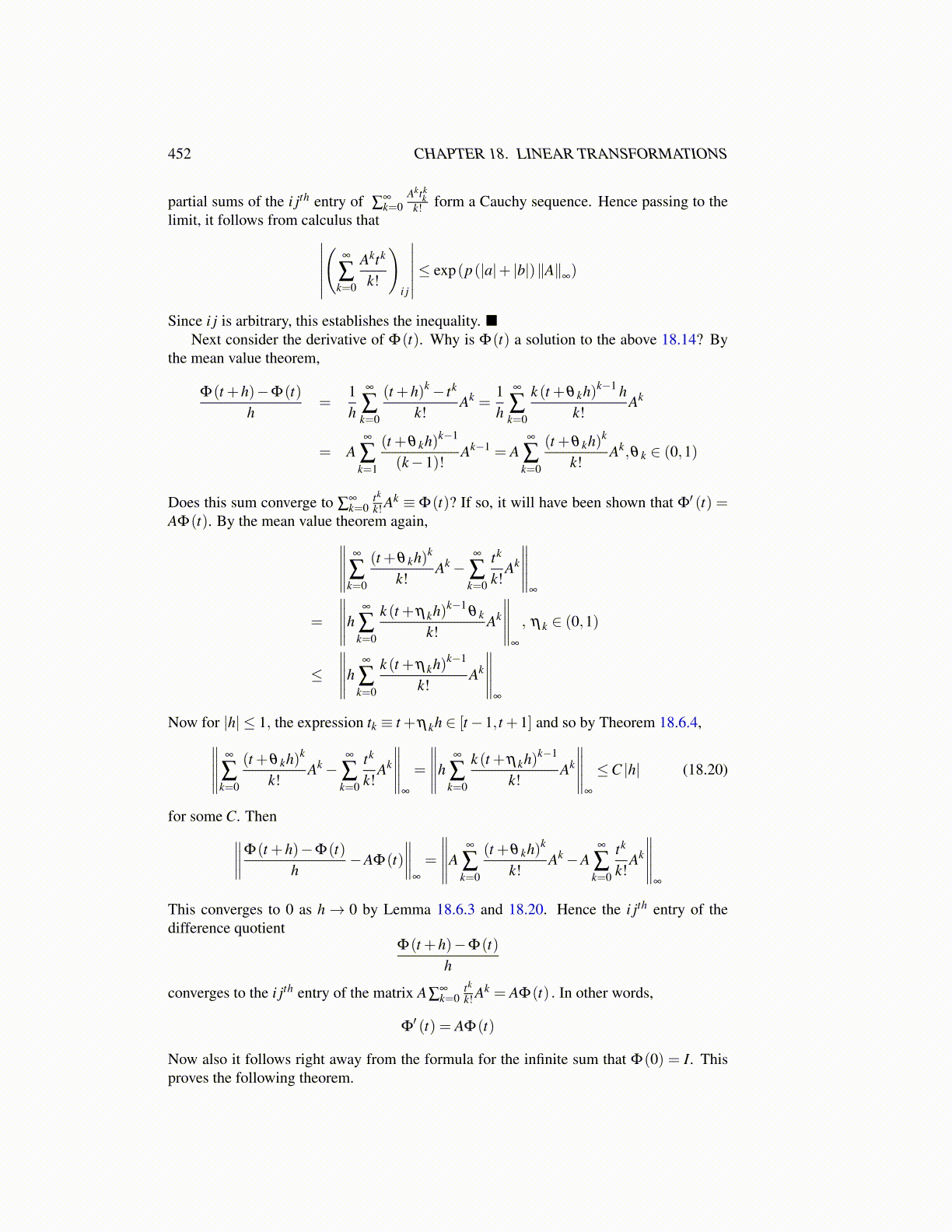
452 CHAPTER 18. LINEAR TRANSFORMATIONS
partial sums of the i jth entry of ∑∞k=0
Aktkk
k! form a Cauchy sequence. Hence passing to thelimit, it follows from calculus that∣∣∣∣∣∣
(∞
∑k=0
Aktk
k!
)i j
∣∣∣∣∣∣≤ exp(p(|a|+ |b|)∥A∥∞)
Since i j is arbitrary, this establishes the inequality. ■Next consider the derivative of Φ(t). Why is Φ(t) a solution to the above 18.14? By
the mean value theorem,
Φ(t +h)−Φ(t)h
=1h
∞
∑k=0
(t +h)k− tk
k!Ak =
1h
∞
∑k=0
k (t +θ kh)k−1 hk!
Ak
= A∞
∑k=1
(t +θ kh)k−1
(k−1)!Ak−1 = A
∞
∑k=0
(t +θ kh)k
k!Ak,θ k ∈ (0,1)
Does this sum converge to ∑∞k=0
tk
k! Ak ≡ Φ(t)? If so, it will have been shown that Φ′ (t) =AΦ(t). By the mean value theorem again,∥∥∥∥∥ ∞
∑k=0
(t +θ kh)k
k!Ak−
∞
∑k=0
tk
k!Ak
∥∥∥∥∥∞
=
∥∥∥∥∥h∞
∑k=0
k (t +ηkh)k−1θ k
k!Ak
∥∥∥∥∥∞
, ηk ∈ (0,1)
≤
∥∥∥∥∥h∞
∑k=0
k (t +ηkh)k−1
k!Ak
∥∥∥∥∥∞
Now for |h| ≤ 1, the expression tk ≡ t +ηkh ∈ [t−1, t +1] and so by Theorem 18.6.4,∥∥∥∥∥ ∞
∑k=0
(t +θ kh)k
k!Ak−
∞
∑k=0
tk
k!Ak
∥∥∥∥∥∞
=
∥∥∥∥∥h∞
∑k=0
k (t +ηkh)k−1
k!Ak
∥∥∥∥∥∞
≤C |h| (18.20)
for some C. Then∥∥∥∥Φ(t +h)−Φ(t)h
−AΦ(t)∥∥∥∥
∞
=
∥∥∥∥∥A∞
∑k=0
(t +θ kh)k
k!Ak−A
∞
∑k=0
tk
k!Ak
∥∥∥∥∥∞
This converges to 0 as h→ 0 by Lemma 18.6.3 and 18.20. Hence the i jth entry of thedifference quotient
Φ(t +h)−Φ(t)h
converges to the i jth entry of the matrix A∑∞k=0
tk
k! Ak = AΦ(t) . In other words,
Φ′ (t) = AΦ(t)
Now also it follows right away from the formula for the infinite sum that Φ(0) = I. Thisproves the following theorem.